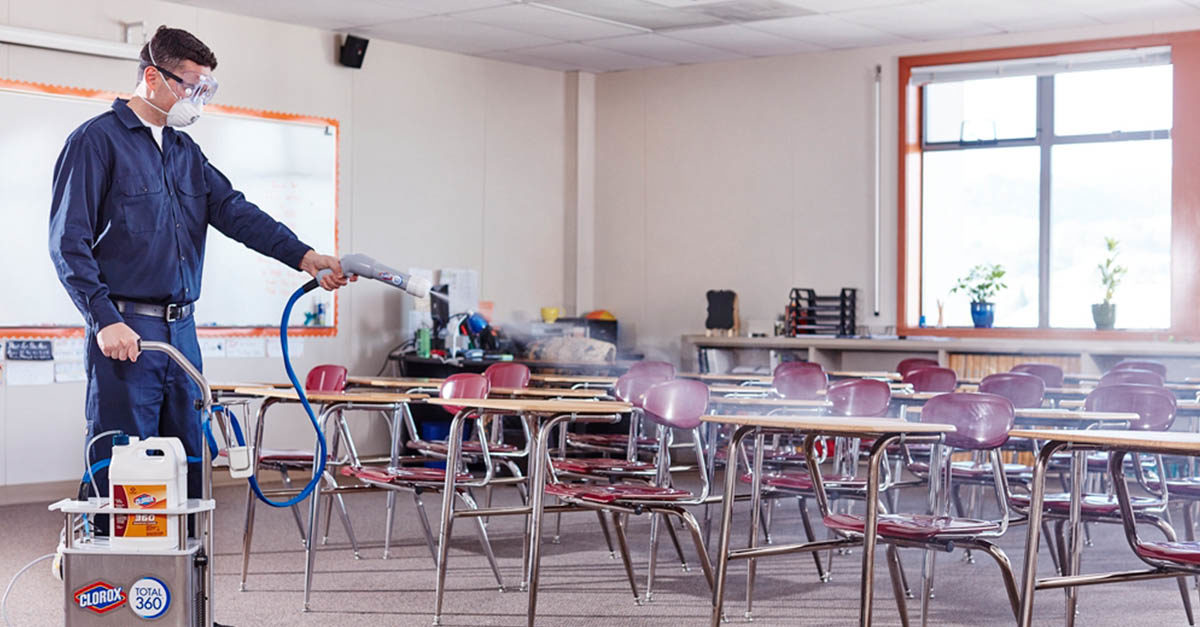Cleaning large spaces can be a challenge, especially if those spaces include various surfaces that are difficult to clean and disinfect. Take a gym, for example. Staff are responsible for cleaning and disinfecting multiple exercise machines and equipment, lockers, and restrooms, all within a limited time.
Traditional wipes and trigger sprays, though effective, require significant effort and can be prone to human error, including missed surfaces. However, regular and comprehensive disinfection of these surfaces is key to reducing the spread of disease-causing pathogens. That’s where electrostatic spray technology comes in handy.
Q. What is electrostatic spray technology?
A. Electrostatic spray technology is a new way to apply cleaners, sanitizers, and disinfectants to help facilities treat surfaces, often in less time and with better coverage than traditional cleaning methods. The technology is well-established, with a history of more than 60 years in other areas, including agriculture, automotive, and tanning industries, but it has only recently been applied to surface disinfection.
Electrostatic sprayers work by charging liquids (i.e., cleaners, sanitizers, and disinfectants) as they pass through a sprayer nozzle. This generates charged droplets that repel one another and actively seek out environmental surfaces, which they stick to and even wrap around to coat all sides. The result is a uniform coating of sanitizer or disinfectant on sprayed objects, including hard-to-reach areas that manual cleaning can miss. The technology also helps avoid liquid pooling often associated with trigger sprayers.
Q. Where can I use electrostatic spray technology?
A. Use electrostatic sprayers anywhere you currently sanitize or disinfect. Effective electrostatic sprayers can cover a large area in minutes, so school classrooms, public restrooms, cafeterias, kitchens, equipment rooms, offices, waiting rooms, and even vehicles can all be treated efficiently. Because surfaces are coated evenly, wiping is not required regularly, only periodically to keep surfaces polished.
Electrostatic spray technology can be tailored to meet facilities’ needs. Some facilities choose to use electrostatic sprayers as a substitute for manual cleaning and disinfecting methods like wipes and trigger sprays, while others use the technology as an additional step to augment standard cleaning and ensure comprehensive surface coverage.
Q. What sprayer system styles are available?
A. There are several electrostatic sprayer options currently on the market so you can find one best suited for your facilities’ individual needs. Be sure to evaluate them for reliability, safety, and ease of use before purchasing.
Responsible manufacturers conduct testing of the entire system—the electrostatic sprayer paired with specific chemistries—to determine the proper personal protective equipment (PPE) for the operator as well as safety considerations for bystanders. Be wary of companies that claim you can spray any product with their system; they likely have not done the proper testing required to ensure operator and bystander safety for the use of all chemicals. Ensure the sprayer itself is certified by a nationally recognized testing laboratory (NRTL), such as Intertek, to confirm electrical safety.
Sprayer systems are available in several designs, such as rolling cart systems, handheld sprayers, and backpack sprayers. Handheld and backpack models offer operators flexibility but can be heavy when filled with liquid. Some sprayers use battery power to impart a charge on liquids, while others use a cord to draw power from a standard outlet plug. Although cords can pose an additional challenge, they provide consistent power and droplet charging, which results in better system performance. Batteries simply aren’t powerful enough to generate a consistent, reliable charge to deliver the electrostatic performance needed to cover surfaces completely and evenly every time you spray.
Corded systems have other inherent benefits that provide superior performance. For example, electrostatic sprayers using outlet power include an air compressor, which reduces blowback by pushing sanitizer or disinfectant liquid toward environmental surfaces and away from the operator. Battery-powered sprayers cannot contain an air compressor and more closely resemble trigger sprayers in terms of coverage and surface wrap.
Whichever sprayer you choose, electrostatic technology can help you cover more surfaces in less time, saving your facility money while providing the surface disinfection you need to prevent the spread of illness-causing pathogens.




